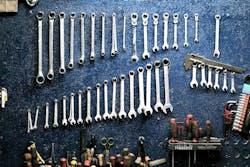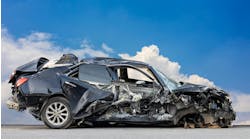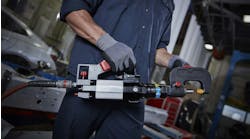Speed matters.
Of course it does, right? Say this is an average week at your shop: Your team pushes out four cars per day and your average repair order sits at $3,000—that week you’ll produce $60,000 of work. And if your gross profit margin sits at 40 percent, you’ve made $24,000.
But then say you are able to get one—just one—more car through your shop per day. That’s an extra $780,000 worth of work heading out the door each year, another $312,000 in your pocket. And if you can raise your gross profit margins past 40 percent? You’ve completely upended your business by getting one more car through.
So, yes, of course speed matters.
But not in the way you think it does, Dave Luehr says.
“Speed is the result of taking the right actions,” said Luehr on a recent FenderBender webinar. “The removal of the bad things in your business is what creates the speed.”
Speed isn’t achieved by beating your employees with a stick, says Luehr, founder of the collision repair consulting firm Elite Body Shop Solutions. In the scenario described above, that one extra car was pushed through by removing clutter in your shop; by eliminating supplements; by upping productivity; by removing idle jobs from your parking lot; by effectively blueprinting repairs. That careful, steadfast, calculated approach to planning out each job and ensuring it can move quickly through the repair process is what creates the speed, what keeps everyone efficient, what maximizes throughput.
So, what’s holding shops back? If true “speed” simply requires revisions to how you plan out each repair, why won’t shops establish blueprinting departments and reduce inventory and cease pre-ordering parts?
Because they are limited by their beliefs, Luehr says. A limiting belief leads to lack of action, which leads to poor results. And until shop owners think beyond the norm, they’ll never push that extra car through.
“We need to get out of our comfort zones,” Luehr says. “In today's day and age, with the technical tsunamis coming at us, you need to learn how to surf.”
Plenty of shops, in fact, have learned to surf that intimidating wave—and they’re here to help. Through interviews with the nation’s top operations and statistical data culled from the FenderBender Industry Survey, here are five repair planning strategies to achieve ultimate throughput.
What is Throughput?
noun
through·put
\ ˈthrü-ˌpu̇t \
Throughput is the rate at which a system achieves its desired goal. It’s measured in the form of units/time: the higher the number of units and the lower the time, the higher the throughput
1. Adopt a Lean Mindset.
One day, Bruce King’s shop had a power outage. And instead of sitting around and waiting for the lights to come back on, he sat down with his staff and handed everyone a sheet of paper and a pencil.
“I asked them, ‘Tell me what a good day looks like,’” King recalls. And, turns out, a good day meant all the paperwork for all repairs was organized; the parts were all ready to go; customers were happy. In essence, ideally, the repair process flowed smoothly and people enjoyed their work.
And in this moment, King realized something scary: There were rarely “good days” at King Collision Center.
“The good day is everything we want from them,” King told his manager at the time. “The bad day is everything we’re doing to them.”
Needless to say, from that day forward, everything changed for King, and he started his slow, gradual move toward lean. And now as an elite mentor with Elite Body Shop Solutions, which strongly preaches the lean system, King teaches the lean mindset to other shops. After passing on his two-shop operation to his sons, he now coaches shop operators how to sidestep barriers that keep vehicles from moving swiftly (and smoothly) through their shops.
The core component of lean—which entails eliminating any and all waste from a production system, aka the Theory of Constraints—becomes the foundation for maximizing throughput. By eliminating unnecessary processes and focusing on the quality and speed of a repair, you can move more vehicles through the shop, King says.
Essentially, you are setting up systems and processes to properly blueprint vehicles. By identifying all the damage, by preparing a pre-made list of parts, and by ascertaining when and where the vehicle will fit into your shop’s busy schedule, you’ve effectively eliminated the possibility of taking in a job that isn’t fully vetted to be profitable—you’ve eliminated waste and only taken work that is set to move smoothly through your repair process.
Advanced Workflow Secrets
Dave Luehr, one of the industry’s foremost experts on shop operations and founder of Elite Body Shop Solutions, discussed on a recent FenderBender webinar the advanced workflow secrets, top operations strategies, and the advanced technology and systems driving the top collision repair businesses forward. Throughout this piece, you can find some key excerpts from Luehr’s webinar.
Watch the entire webinar at fenderbender.com/UltimateThroughput.
The Theory of Constraints
Emphasis in the repair process is placed on the constraints in the procedure. The constraint is then always being “fed” more work. Create a buffer of work before that source. The Theory of Constraints model is less limiting than a typical lean model. A lean practitioner constantly removes waste from the shop system but does not necessarily take into account that bottlenecks in the repair happen.
The Bottleneck Fix
Often, when an owner is asked about his or her bottleneck, he or she will respond with, “on which day?” If there is a bottleneck in your production, you need to work with your team to find it, Dave Luehr, founder of Elite Body Shop Solutions, says. A Theory of Constraints practitioner will figure out where the production stop occurs and then overbook or overschedule before that area to make sure the bottleneck has plenty of work and is “fed.”
The Staggered Schedule
While it might create some pressure, shops should stop only bringing in cars on Monday, Dave Luehr, founder of Elite Body Shop Solutions says—even on Thursday and Friday. By scheduling cars each day, it reduces your work in progress (aka WIP), specifically if there is a mix of small and medium jobs per day, Luehr says. At least stagger scheduling and maybe bring in seven cars on Monday instead of all 20 vehicles.
And, don’t be afraid to bring in cars and have them sit over the weekend, he says. Painters will want work to do after the weekend on Monday morning.
The WIP Calculation
Following Little’s Law, which Dave Luehr, founder of Elite Body Shop Solutions, says he learned from Rich Altieri, owner and consultant at Autobody Management Solutions, work in progress (WIP) is calculated by how many vehicles delivered each month divided by working days. The end result is how many vehicles the shop should be producing each day.
The Modern Estimate
Vehicle damage assessment is a term popular in the U.K right now, Dave Luehr, founder of Elite Body Shop Solutions, says. Other names for this are “enhanced appraisals” or “smarter estimating.” In this process, the customer is scheduled for 35 minutes to an hour for an appraisal on lighter jobs. This is a time when staff take time to do pre-repair scans and research OEM repair procedures before ordering the parts.
The Insurance Adjustment
If your shop is DRP heavy, you have to base your system around program needs, Dave Luehr, founder of Elite Body Shop Solutions, says. Basically: adjust and adapt. For shops with insurance companies on site, if you have a situation in which you don’t know when a job will come in, then block off times in advance for that to happen. If the insurance companies end up not bringing in a car, then schedule someone else to come in.
Lean vs. Non-Lean
Of the 300 respondents who filled out the FenderBender Industry Survey, 46.4 percent of shops claim to have incorporated lean processes into their businesses. Based on that survey data, here are the key differences between shops that have and haven’t gone down a leaner path.
Annual Revenue Over $2.5 Million
Lean Shops: 59%
Non-Lean Shops: 24%
Cycle Time Under 7 Days
Lean Shops: 81%
Non-Lean Shops: 70%
Touch Time Above 4 Hours
Lean Shops: 55%
Non-Lean Shops: 45%
CSI Above 90%
Lean Shops: 88%
Non-Lean Shops: 88%
Average Repair Order Above $3,000
Lean Shops: 48%
Non-Lean Shops: 48%
Supplement Ratio Below 25%
Lean Shops: 70%
Non-Lean Shops: 65%
Gross Profit Margin on Material Sales Above 30%
Lean Shops: 68%
Non-Lean Shops: 48%
Gross Profit Margin on Parts Sales Above 30%
Lean Shops: 58%
Non-Lean Shops: 56%
Gross Profit Margin on Labor Sales Above 50%
Lean Shops: 74%
Non-Lean Shops: 45%
Overall Gross Profit Margin Above 40%
Lean Shops: 74%
Non-Lean Shops: 49%
Overall Net Profit Margin Above 11%
Lean Shops: 51%
Non-Lean Shops: 43%
Productivity Above 100%
Lean Shops: 79%
Non-Lean Shops: 60%
Efficiency Above 140%
Lean Shops: 56%
Non-Lean Shops: 30%
Key “Lean” Books
—
One of the biggest pieces of advice Bruce King, an elite mentor with Elite Body Shop Solutions, can offer to shops looking to adopt a lean mindset is to study up. Here are three books he strongly recommends.
The Machine That Changed the World
by James P. Womack, Daniel T. Jones, and Daniel Roos
Based on a gigantic, detailed study—MIT's five-year, 14-country International Motor Vehicle Program—this book describes the entire managerial system of lean production.
The Toyota Production System: Beyond Large-Scale Production
by Taiichi Ohno
Ohno’s book argues that any sized business can learn and profit much more from Toyota by focusing on the thinking that created the Toyota production system than they can by copying the system itself.
Lean Thinking: Banish Waste and Create Wealth in Your Corporation
By James P. Womack and Daniel T. Jones
Split into four parts, this renowned book on lean takes a look at the processes that led to Toyota becoming a leader of the global motor vehicle industry.
2. Set the Course Each Morning.
Tony Garris joined the collision repair industry in 1979—but his career did not start in collision repair. Garris began in the parts department of dealerships, and he stuck with it until Fred Beans, of Fred Beans Family of Dealerships, talked him into a new role: managing the company’s flagship 45,000-square-foot collision repair center.
And while that level of oversight may seem too daunting to someone who just made the transition from collision to parts, Garris still, to this day, views the art of moving cars from Point A to Point B in the body shop in a pretty simple light.
“A lot of that does not have to be rocket science or complicated,” says Garris, now the collision director for Dayton Collision Center in Dayton, N.J. Garris has bounced between different collision repair shops in his career and finds it fairly easy to identify areas in which processes are eroded or prove to be inefficient.
And it’s worked out fairly well: Daytona Collision’s cycle time rests under seven days, its touch time is above four hours, and its efficiency and productivity eclipse 160 percent and 110 percent, respectively. But before he can even begin to form lean processes to hit those kinds of numbers, Garris says he needs to figure out how each member of his team fits into those processes.
One tactic that’s helped immensely is hosting a production meeting each morning. The meeting only lasts 10–15 minutes, and each department discusses what is in production for the day. Without a morning release meeting, the technicians and other staff members at Dayton Collision are not aware of mishaps or issues taking place in other areas of the process. By identifying those pitfalls, he’s able to address them up front and sort them out before a vehicle heads into the first stage of repairs.
It’s all about creating a culture of continuous improvement, Garris says. At each stage of the repair, take into account how eliminating waste in that part could impact the person who is working on the vehicle next.
One solution is introducing a concept of process mapping to the team, he says. At each step in the process, walk the team through it and then outline the opportunities for improvement.
Dissecting Cycle Time
In the FenderBender Industry Survey, 53.1% of shops have kept their job-start-to-job-completion cycle times between 5–7 days. Shops that hit this range, according to shop consultant Bruce King, owner of King’s Collision Centers, are likely bringing in more profitable work that has been properly blueprinted in order to avoid hiccups during the repair processes.
The statistics that immediately follow are the characteristics of a shop that achieves that 5–7 day range.
Shops with 5–7 Day Cycle Times
Touch Time Above 4 Hours: 51%
Supplement Ratio Below 25%: 73%
Gross Profit Margin on Material Sales Above 30%: 59%
Gross Profit Margin on Parts Sales Above 30%: 55%
Gross Profit Margin on Labor Sales Above 50%: 64%
Overall Gross Profit Margin Above 40%: 71%
Overall Net Profit Margin Above 11%: 42%
3. Determine Your Optimum Schedule.
Say you own a pizza shop—the best pizza shop in town, in fact. People love your pizza, and you can produce way more of it than your competitors. While other pizza shops can pump out 10 pizzas per day, your staff can manage 20.
Now, say you want to make twice as much money—that requires 40 pizzas per hour. So instead of cooking pizzas at 300 degrees for 10 minutes, you decide to start cooking them at 600 degrees for 5 minutes. Your output goes up...and your quality goes down.
It’s a long walk, but this is the example King uses when coaching shops to get across one simple point: You don’t mess with a good product.
“One of the biggest biggest killers in excess inventory,” he says. “We schedule too much work because we’re scared of losing jobs.”
Here’s what the pizza shop should actually do: Continue to schedule 20 pizzas per hour until it can improve its processes and become efficient enough to build the pizzas more quickly. Likewise, a body shop should determine how many quality repairs it can churn out per week and then schedule that many cars. You should absolutely not, as King puts it, “be running a parking garage.”
“People don’t do business with companies, they do business with people,” he continues. “We know what we can do, so we don’t get emotional for telling someone we can’t their touch car for three weeks. If you’ve built a good reputation, they might wait.”
Garris says that when scheduling work, take into account the size of the repair job. Otherwise a painter could end up having 15 hours of work in one day with 1–2 hours every other day of the week.
Depending on where the shop is located, a shop owner should remember to prepare for tow-ins when scheduling, Garris also suggests. In the Northeast, he receives roughly three to four times more tow-ins due to weather conditions in the winter versus during the summer time.
Ultimately, build the schedule around each technician’s skills and how many technicians are in the shop, he says.
Dissecting Touch Time
Touch time quite literally measures the amount of time a technician touches a vehicle per day. So, if a car takes five days to go through your shop and it received 20 hours of billed work, then your shop spent 4 hours a day touching that job.
Improved touch time is a key signifier of lean practices, Dave Leuhr, founder of Elite Body Shop Solutions, says. Waste creates delays, which lead to idleness, which leads to lower touch times. Eliminating waste improves touch time, which in turn improves productivity, efficiency, cycle time—the list goes on.
Here’s how varying levels of touch time play affect three essential KPIs that signify optimal throughput.
High vs. Low Touch Time
Efficiency Over 120%
-
Touch Time 2–3 Hours: 53%
-
Touch Time 4–5 Hours: 78%
-
Touch Time 6–7 Hours: 70%
Productivity Over 100%
-
Touch Time 2–3 Hours: 49%
-
Touch Time 4–5 Hours: 68%
-
Touch Time 6–7 Hours: 79%
Gross Profit Over 40%
-
Touch Time 2–3 Hours: 40%
-
Touch Time 4–5 Hours: 56%
-
Touch Time 6–7 Hours: 65%
4. Schedule Estimates for Guaranteed Work.
There can be a lot of pressure to schedule out several estimates per day, provide walk-in estimates for customers, placate to insurers’ demands at the drop of a hat.
But if you properly dictate your estimating schedule, you’re not adhering to anybody’s needs but your own—and you’ll write less estimates.
“We’ll tell a customer they don’t need an estimate—they need a car repair,” King says.
At the end of the day, why write an estimate for work you may not obtain, or work that will sit in your lot for weeks?
“Nobody will know what’s wrong until we dismantle and study every part for damage, document it, and get the insurer to pay for it. Then, and only then, will anybody know what's wrong and what parts we’ll need and how long it’ll take to repair the car,” he says.
King says to only schedule estimates when you’re certain that you’ve identified the damage, that you’ve received approval from insurance, that it can fit into your strict shop schedule. Don’t assume the work will take place before spending the time and money writing an estimate.
Garris has an interesting point of view on estimates: They should only be scheduled for Saturdays. With his shop open on that normal off day, this is especially optimal since there is only one estimator on site. For shops not open on Saturdays, he says to schedule estimates for days when the staffing is thinner.
Above all else, the customer needs a convenient process from the shop, he says. And this system works best for people with busy schedules.
Dissecting Supplement Ratio
Every shop owner knows this, Bruce King, founder of King’s Collision Centers, says, but technicians are paid to repair vehicles and not write supplements. Yet, supplements persist, as 55% of respondents in the FenderBender Industry Survey report a supplement ratio of 16% or higher.
By not disrupting the repair process for supplements, the survey data indicates that shops experience higher sales and happier customers. Here’s the difference between shops with high and low supplement ratios.
Key-to-Key Cycle Time Below 8 Days
Supplement Ratio 0–15%: 84%
Supplement Ratio 16%+: 59%
Touch Time Above 4 Hours
Supplement Ratio 0–15%: 58%
Supplement Ratio 16%+: 52%
NPS Above 90%
Supplement Ratio 0–15%: 72%
Supplement Ratio 16%+: 63%
Gross Profit Margin on Parts Sales Above 30%
Supplement Ratio 0-15%: 64%
Supplement Ratio 16%+: 42%
Net Profit Margin Above 11%
Supplement Ratio 0-15%: 58%
Supplement Ratio 16%+: 43%
5. Stop Pre-Ordering Parts.
It requires a lot of time, money and effort to receive parts for a repair, to check those parts, to label those parts, to store those parts. And then all those expenses have to go through your accounting. And then those parts have to be documented and tracked.
And then, after you’ve torn down the vehicle and discovered another part is required, the process starts all over.
Perhaps it goes without saying, at this point, but the lean-focused King would like to point a pretty obvious fact: This produces no value for your shop.
“Our return rate used to be really high,” he says. “Now our parts return rate is next to nothing. We don’t pre-order parts, because it’s a waste of time.”
If you’ve performed a full assessment of the vehicle and ensured all repairs will be paid for, your staff is not “pre-ordering” parts—it is simply ordering the parts that it knows will produce work, produce value for your shop.
Dissecting Gross Profit Margins
If you’re truly running a lean operation, then you’re cutting down on unnecessary materials, you’re only ordering the parts you need, and you’re not wasting a single minute of your employees’ time—in effect, you’re improving gross profit margins on materials, parts and labor sales, respectively.
Here are four key KPIs that make a huge difference between high and low gross profit margins.
Key-to-Key Cycle Time Under 7 Days
Gross Profits on Materials Sales Above 30%: 72%
Gross Profits on Materials Sales Below 30%: 61%
Gross Profits on Parts Sales Above 30%: 73%
Gross Profits on Parts Sales Below 30%: 71%
Gross Profits on Labor Sales Above 50%: 85%
Gross Profits on Labor Sales Below 50%: 68%
Touch Time Above 4 Hours
Gross Profits on Materials Sales Above 30%: 53%
Gross Profits on Materials Sales Below 30%: 42%
Gross Profits on Parts Sales Above 30%: 50%
Gross Profits on Parts Sales Below 30%: 45%
Gross Profits on Labor Sales Above 50%: 58%
Gross Profits on Labor Sales Below 50%: 52%
Technician Efficiency Above 140%
Gross Profits on Materials Sales Above 30%: 67%
Gross Profits on Materials Sales Below 30%: 49%
Gross Profits on Parts Sales Above 30%: 46%
Gross Profits on Parts Sales Below 30%: 42%
Gross Profits on Labor Sales Above 50%: 50%
Gross Profits on Labor Sales Below 50%: 36%
Technician Productivity Above 100%
Gross Profits on Materials Sales Above 30%: 88%
Gross Profits on Materials Sales Below 30%: 61%
Gross Profits on Parts Sales Above 30%: 57%
Gross Profits on Parts Sales Below 30%: 73%
Gross Profits on Labor Sales Above 50%: 84%
Gross Profits on Labor Sales Below 50%: 60%




